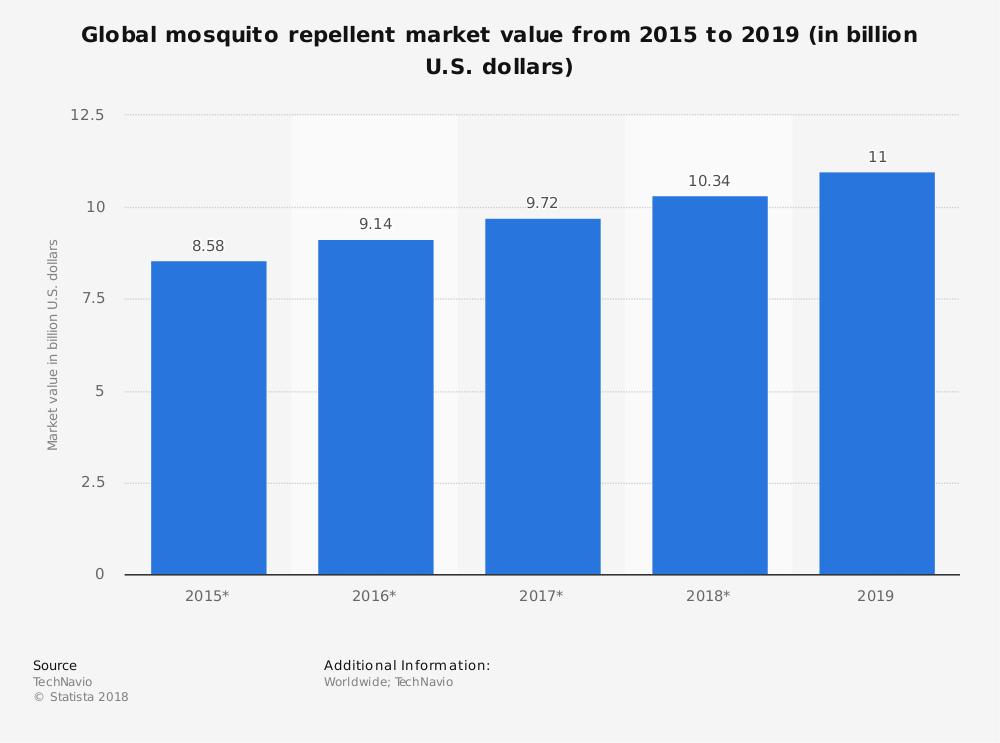DEET was first discovered in 1946. The first mosquito repellent approved for sale in the United States with DEET hit store shelves in 1956. Since then, this mosquito repellent compound has been the most widely sold repellent. It is generally regarded as safe, though certain side effects, which could be potentially life-threatening, have been recorded.
DEET is a synthetic repellent which was initially developed by the U.S. military. Samuel Gertler is credited with receiving the first patent for an insect repellent using DEET in powders, creams, and lotions.
Important Mosquito Repellent Industry Statistics
#1. The global mosquito repellent industry market has an estimated value of about $11 billion annually. (Statista)
#2. Of the 65 mosquito repellent formulations that are known to be produced outside of the United States, about 50% of them contain DEET. The other half contain natural oils. (Research Information UK)

#3. Repellent manufacturing in the United States is a segment which produces about $393 million in revenues annually for the industry. Over the last 5-year period, the manufacturing segment has contracted by an average of 4.5% each year. (IBIS World)
#4. There are just 35 firms currently active in the repellent manufacturing industry in the United States. Those firms are responsible for the employment of about 300 people. (IBIS World)
#5. The most popular brand of insect repellent in the United States is Coleman. In 2017, more than 6.1 million Americans purchased at least one bottle of bug spray sold by the Coleman brand. (Statista)
#6. Supermarkets, hypermarkets, and convenience stores are the most popular retail locations for consumers to purchase mosquito repellents. (Technavio)
#7. Sprays, vaporizers and coils, hold the largest market share within the mosquito repellent industry. These three products combine to account for more than 60% of all sales for the industry. (Technavio)
#8. 56% of the global revenues generated by the mosquito repellent industry come from the Asia-Pacific region. For the next 5-year period, sales in this region are expected to increase by more than 1%. (Technavio)
#9. In 2015, fears of the Zika virus prompted a surge in the sales of mosquito repellent in the United States. Product sales topped $516 million for the year, which was an increase of 11.2%. (CBS News)
#10. Zika concerns have caused S.C. Johnson to experience sales increases of up to 150% for some of their bug spray brands when compared to sales figures from the year before. (CBS News)

#11. Up to 78 million people in the United States, and 200 million people globally, use a mosquito repellent which contains DEET on a regular basis. (Smithsonian)
#12. As of 2015, there were 3.4 million people in the world who are deemed to be at-risk of catching malaria. Mali had the highest number of new malaria cases recorded. (Statista)
#13. The most common mosquito-borne disease diagnosed in the United States is the West Nile Virus. (Statista)
#14. More than $500 million is vector-borne disease funding was provided by the National Institutes of Health in 2016. (Statista)
#15. 405 of doctors in the United States believe that the health of their patients is being impacted by climate change because of how that affects mosquito-borne infections. (Statista)
#16. About 2,100 cases of West Nile Virus were diagnosed in 2015. The most common state for a West Nile infection in the U.S. is California. About 150 people died because of complications related to this virus that year. (Statista)
#17. About 1,100 cases of Zika were recorded in Florida in 2016. (Statista)
#18. About 50% of adults in the United States say that they specifically use a mosquito repellent as a preventative measure against the Zika virus. (Statista)
#19. There are about 3,000 known mosquito species that can be found globally. In the United States, there are 176 recognized species that are active. (American Mosquito Control Association)
#20. A person who is moving in an environment which contains mosquito is up to 50% more likely to be bitten than someone who is not moving.

#21. Mosquito repellent is needed on evenings when there is a full moon. A research study indicates that mosquito activity increases by 500% when the moon is full, and the night is warm. (American Mosquito Control Association)
#22. Two primary attractants for mosquitoes are lactic acid and carbon dioxide. People who are active, fidget a lot, or are overweight create more of these natural attractants. (American Mosquito Control Association)
Mosquito Repellent Industry Trends and Analysis
The mosquito repellent industry faces a number of challenges in the coming years. It is a seasonal product, which means consumers in the northern or far southern areas of the world may only need to purchase this product 4-7 months out of the year.
The fears of mosquito disease transmission have also decreased over time, which has affected the industry in the past 5-year period as well. Although rising levels of Zika and West Nile have spurred some regional sales, the overall trend for consumers is to focus on natural repellents instead of ones that contain DEET.
Look for the mosquito repellent industry to make adjustments that will appeal to consumers who want more natural products. There will still be high demand levels globally where disease issues, such as malaria, are still present. For the rest of the world, however, the industry will need to transition and innovate to reverse the trend of contracting revenues.
Although millions of people visit Brandon's blog each month, his path to success was not easy. Go here to read his incredible story, "From Disabled and $500k in Debt to a Pro Blogger with 5 Million Monthly Visitors." If you want to send Brandon a quick message, then visit his contact page here.
